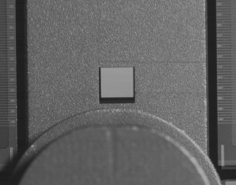NIRSpec IFU Operations
The JWST NIRSpec integral field spectroscopy (IFU) science mode operations includes applicable target acquisition methods, dithers and nods, and special considerations relevant to IFUs.
On this page
Integral field spectroscopy using the NIRSpec integral field unit (IFU) delivers spectral information for every spatial position across a 2-dimensional field. This NIRSpec observing mode is especially suited to study spatially extended sources. The observable wavelength range in IFU mode is 0.6–5.3 μm with spectral resolutions R = 100, 1,000, or 2,700.
When NIRSpec is in IFU mode, the NIRSpec micro-shutter assembly (MSA) shutters are configured "all closed," and the MSA magnet arm is moved to its "IFU" position (Figure 1). In this configuration, light entering the 3" × 3" IFU aperture will be sliced into 30 individual slit spectra that are aligned to form a pseudo long slit on the selected prism or grating. When dispersed, these slice spectra cover nearly the entire active detector area (Figure 2). When the IFU is not in use, the MSA magnet arm is moved to its primary park position so that the blocking lid on the MSA magnet arm (shown in Figure 1) covers the IFU entrance.
Target acquisition for the IFU
See also: NIRSpec Target Acquisition Recommended Strategies
Target acquisition may be used to refine telescope pointing beyond what is achieved by the telescope blind pointing accuracy. Observers should consider pointing accuracy requirements when deciding whether or not to perform target acquisition. If the target is an extended source, more precise positioning may be needed to observe as much of the desired region of the extended emission as possible. Similarly, if a large nod or dither pattern is used, placing the target closer to the edge of the field of view, then target acquisition may be advisable. On the other hand, target acquisition and its associated overheads may not be necessary when observing a single, compact source.
There are 2 possible methods for IFU observing target acquisition: (1) the default wide aperture target acquisition (WATA), and (2) MSA target acquisition (MSATA) with reference stars observed through the MSA to accurately position targets. Because of increased overheads and scheduling constraints, the latter method is not generally recommended unless WATA is infeasible.
Some targets may tolerate less precise initial placement delivered by guide star acquisition. In those cases, other options are provided: (1) NONE, which allows the user to opt out of target acquisition and verification imaging, and (2) the pointing verification image mode (VERIFY_ONLY) which allows for verification of the pointing but does not actually perform a target acquisition.
An overview of all TA methods is provided in the article NIRSpec Target Acquisition.
Dithering with the IFU
See also: NIRSpec Dithering Recommended Strategies
Improvement of the spatial sampling is possible through various dithering options available for the IFU mode. Details can be found in NIRSpec IFU Dither and Nod Patterns. In this case, multiple exposures are taken, separated by small angle maneuvers with typical amplitudes of a few tenths of an arcsec. Dithering also facilitates corrections for bad detector pixels and imperfectly corrected cosmic rays, and mitigates the effects of individual failed open MSA shutters on IFU science exposures.
MSA leakage calibration exposures and correction in IFU data
See also: NIRSpec MSA Leakage Subtraction Recommended Strategies, NIRSpec Bright Spoilers and the IFU Recommended Strategies
The MSA leakage is unwanted flux that makes its way through the NIRSpec MSA shutters, and thus can negatively affect science exposures in the IFU mode. There are various mechanisms for correcting such leakage signal. These are explained in detail in the article NIRSpec MSA Leakage Correction for IFU Observations. The APT template for the IFU mode includes an option to obtain dedicated calibration exposures that can be used to subtract the MSA leakage flux in the pipeline processing of IFU science data.
Mosaicking with the IFU
See also: JWST Mosaic Overview
Mosaicking with the NIRspec IFU is a feature that allows for 3-D spectral mapping of an extended region that is larger than the 3" × 3" single IFU pointing footprint. Figure 3 shows an example. Users may choose from options in APT to define the number of rows and columns of the mosaic pattern, as well as the offset and overlap between different exposures that create the mosaic. Individual pointings in an IFU mosaic are called "tiles," and a NIRSpec IFU mosaic tile pattern rotates as a solid body with changes in JWST orientation. Square IFU mosaics are less affected by the selected aperture position angle, hence proposals to map out square regions with the NIRSpec IFU can be more flexibly scheduled and should not request an aperture position angle constraint at proposal submission (unless necessary to avoid light leakage from bright spoilers in the MSA field of view). However, IFU mosaic patterns that map a rectangular region of the sky should have an orientation special requirement selected to define the acceptable position angle range for the observation.
Target Groups with the IFU
The use of "Target Groups" with the IFU enables some key functionality for certain IFU science cases: (1) observing several nearby targets in a single observation (or even a single visit), with or without mosaicking, and (2) observing targets and associated off-scene dedicated background fields in a single observation, as described in NIRSpec Dithering Recommended Strategies. Both strategies save guide star and target acquisitions and can make for more efficient IFU observing. There are example IFU observing cases that illustrate the use of these capabilities.
IFU background subtraction
Information on JWST background can be found in the JWST Background Model article and considerations for observing with the NIRSpec IFU are in the JWST Integral Field Spectroscopy article. The article NIRSpec Background Recommended Strategies has some additional information.


